Jesus, Webcam Girls, Gyms, and the Oil Embargo of 1973
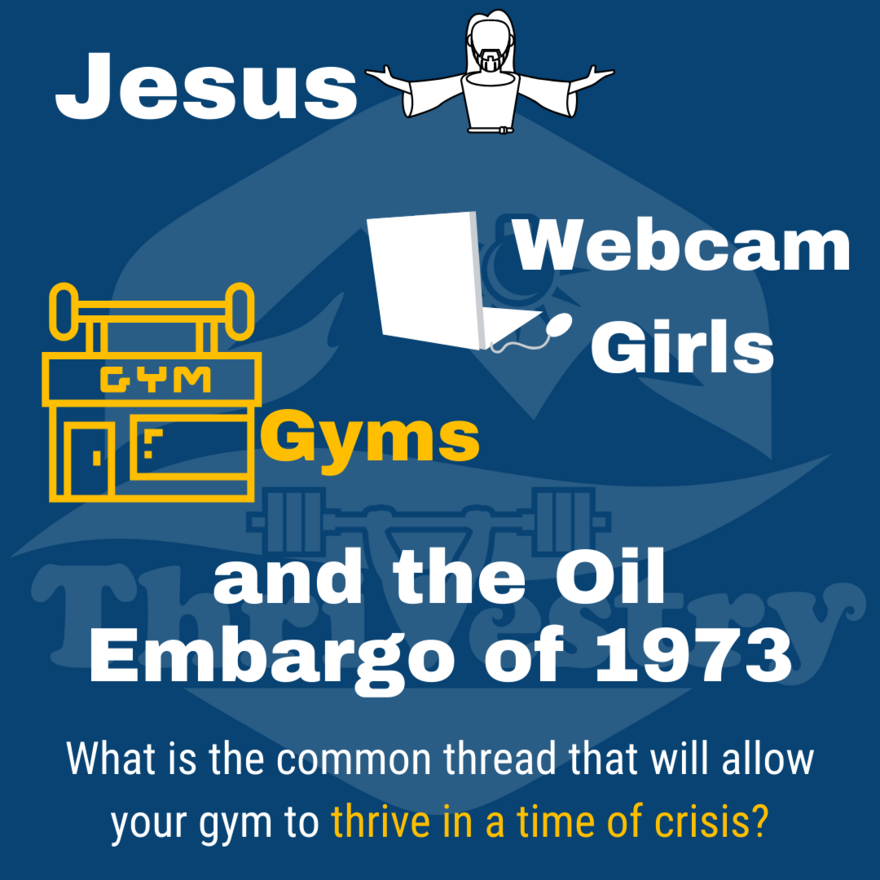
I assure you… the title is not clickbait. (Refill you coffee or adult beverage, this is a long one. It might be a good idea to bookmark it to review again in the future because understanding it can change your whole perspective on coaching and leadership… -jj)
There are some important lessons we can take from these things if we look at them through the lens of a single principle. A principle that most (if not all) successful coaches, gyms, mentors, and businesses follow (whether they know it or not):
Relationship Before Challenge
Let us first start with where I was introduced to this concept: Jesus.
I meet with Sean Bloomquist (A Pastor who teaches Pastors all over the world) and a few other men once per week at one of our houses to work on being better humans. To be more deliberate with our “Up” (relationship with God), our “In” (relationships with our close friends and family), and our “Out” (interactions with acquaintances and strangers).
Primarily we hold each other accountable, learn how to be better leaders/followers, give each other different perspectives, and call each other out on our bullshit.
One of the principles that Sean taught us is how Jesus lead and how most successful leaders/mentors help people create meaningful change.
“Follow me. I will make you fishers of men.” - Matthew 4:19
A theme of Jesus’ teachings is how he used empathy to build relationships BEFORE asking his disciples to do challenging things. “Follow me” (invitation/relationship). “I will make you fishers of men” (challenge).
No matter what your feelings are about religion or Christianity, there is ample historical evidence that there was a guy 2000 years ago who built up quite a large following in a few short years (before the internet even!), and that his influence has made a lasting impact on the world.
That said, you don’t need to subscribe to the “Christianity Email List” to get the benefits of this principle.
(and we will get to the Camgirls later).
One of the easiest ways to understand this concept is to set it up as a graph or matrix:
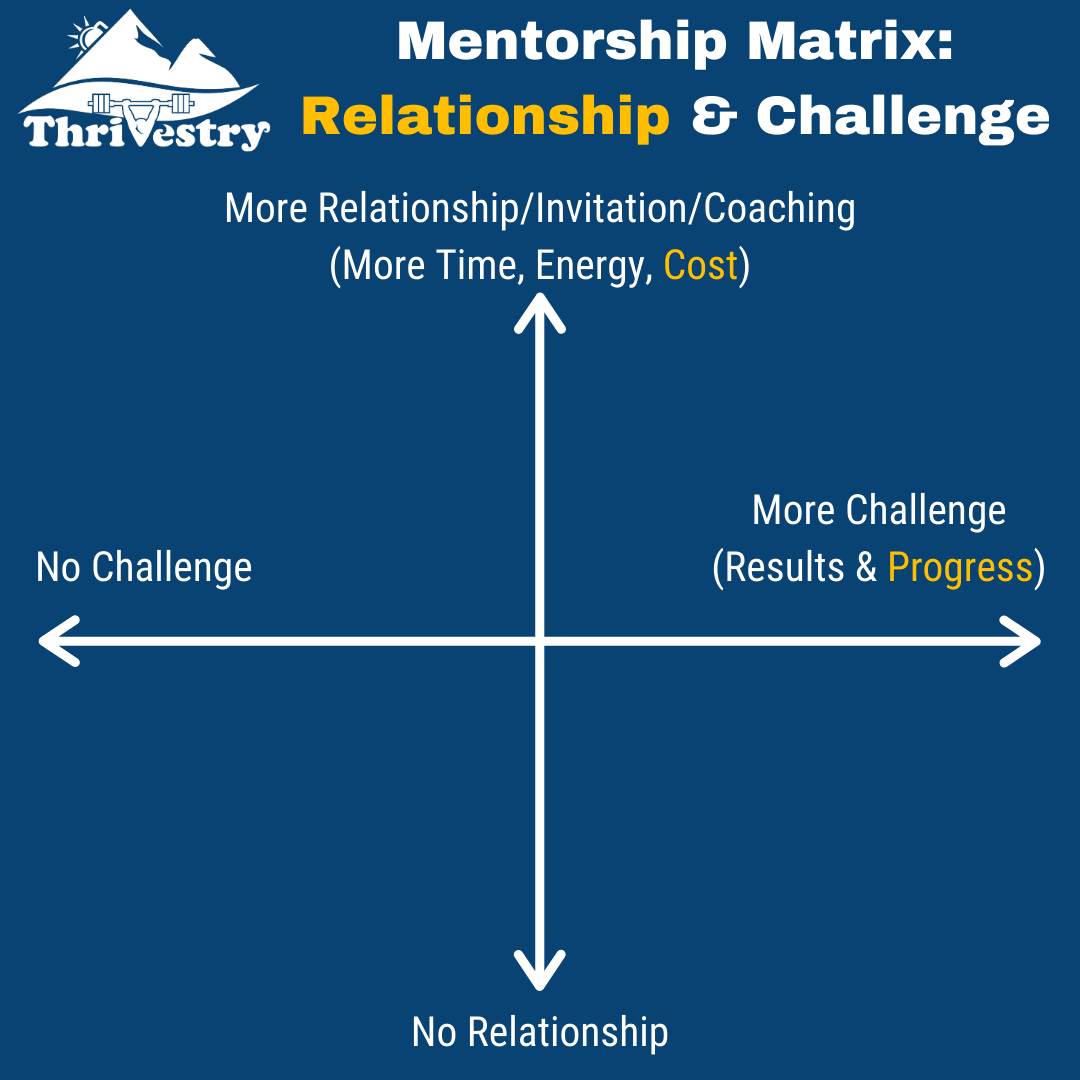
You can see that the top of the matrix is more “Relationship”. This involves more quality time with a person. More empathy/invitation. More Energy. And, usually, more cost (for all of the time/energy of the coach/mentor).
To the right of the matrix, you have more “Challenge”. Challenge is people going out of their comfort zone. Asking them to take on more responsibility. It is more difficult movements. More practicing on their own. More work on their habits by themselves. More ‘figuring it out on their own’. It also means more ‘challenge’ relative to their bank account. More challenge to their schedule or disruption to their routines/lifestyle.
Here are the 4 quadrants with a basic description:
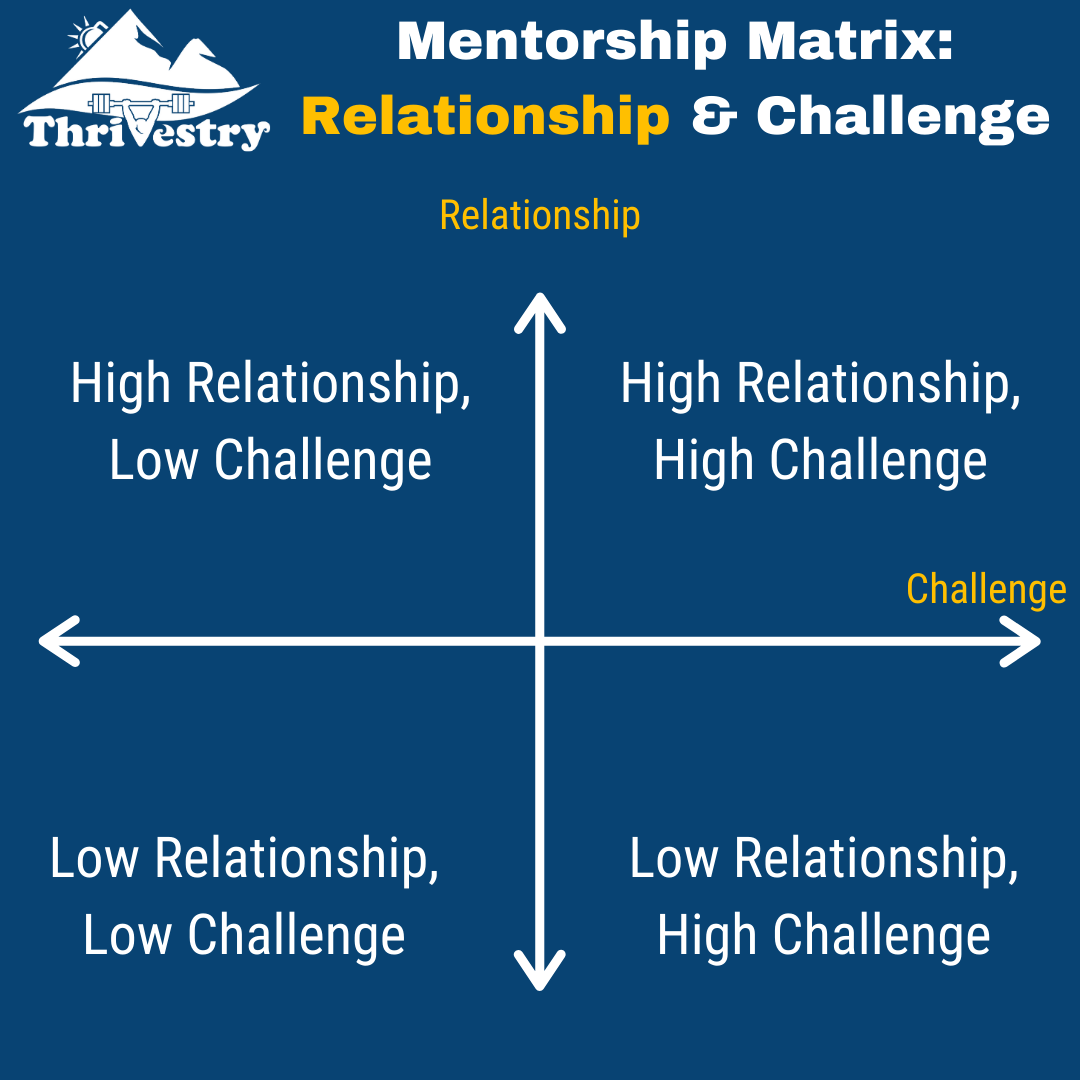
Each quadrant generates specific ‘feelings’ and leads to different outcomes.
The two quadrants on the left (both ‘low challenge’) are where most people outside of our gyms end up being. People who are working out on their own (at home or at a ‘globo gym’), end up in the lower left quadrant. This is also where some people end up at their job when there is no good leadership/management (and the job tasks are easy/boring).
People who pay for a personal trainer who is just there to ‘talk your ear off’ and aren’t giving you any real push or coaching are in the upper left quadrant. In the workplace, this would be where a leader micro-manages you or when management never lets you make any decisions or take on new responsibilities.
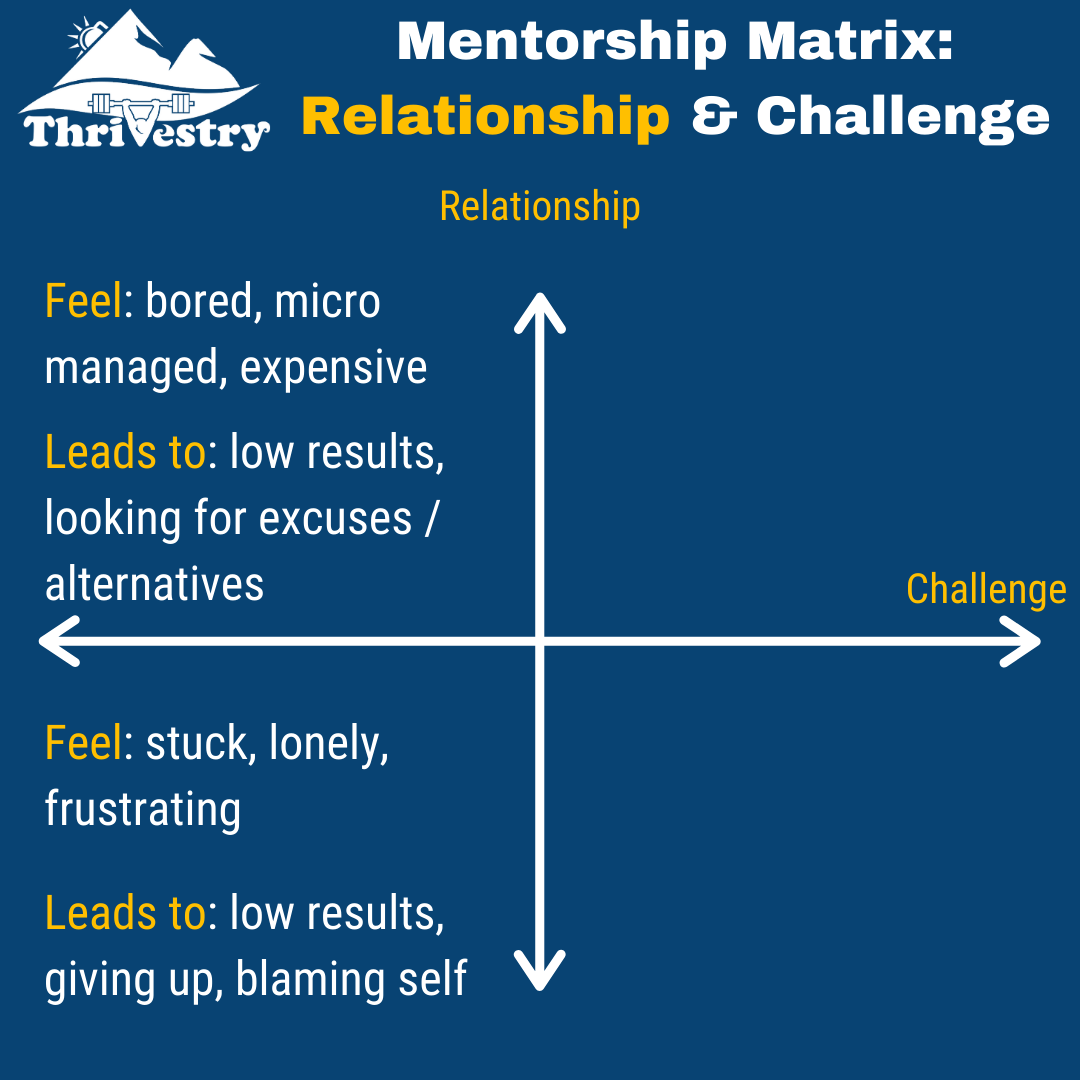
Side note: While we are talking primarily about people in the gym. This principle applies to managers and direct-reports in all organizations. It applies to sport coaches and team members. It applies to teachers and students…
In the CrossFit world, most gyms and CrossFitters struggle with the bottom right quadrant: Low Relationship, High Challenge:
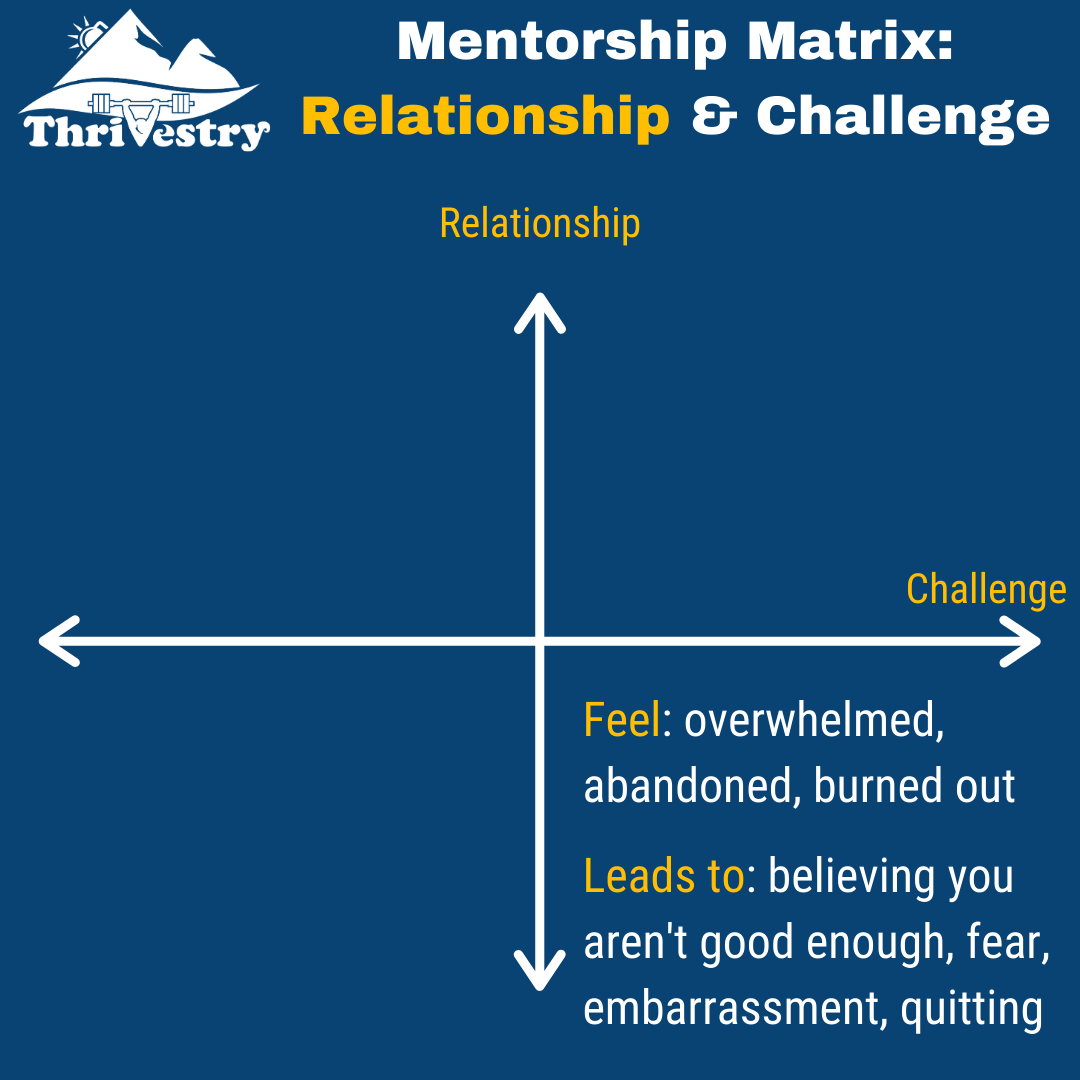
For the ‘average’ person, CrossFit is overwhelming and scary. There is too much challenge for them to handle. We (CrossFit Coaches) don’t see this as the case, but the numbers do not lie; in most gyms, 4 out of every 5 people who sign up do not make it past the 3-6 month mark.
We are asking too much of them without enough relationship. They feel overwhelmed, abandoned, burned out, and like they aren’t good enough.
While it is true that SOME people do well in this environment. These people are a very small subset of the population (about 10-20%). Those who are already decently fit, who have a history of overcoming challenges, or who thrive in the competitive atmosphere. Most of these people have already tried CrossFit and have drank the Kool-Aid or have decided it isn’t for them. They generally aren’t the people who need our help the most! The rest of the population (80-90%), will not thrive in a low relationship, high challenge environment.
And finally, we have the sweet spot: High Relationship, High Challenge:

This is where we can reach the most amount of people and produce the best results.
When operating in this quadrant, we are meeting people at their level and then tailoring the demands based upon them individually.
We can home in on what really drives them (sometimes they don’t even know themselves). We can help them set goals and create plans and routines to help them get there. We are also able to adapt and react more quickly when new things come up.
More importantly, they have a person they trust ‘in the boat’ with them. Someone to hold them accountable. And someone who knows when to crack the whip and when to back off.
When a client has built a strong relationship with their Coach/Mentor, they will listen better. They will try harder (inside and outside of the gym). They will overcome resistance and setbacks more frequently.
This is the ‘ideal client’. Someone who is a true fan of what you do and is willing to pay more (and stay with you through thick-and-thin).
The Mentorship Matrix and the Fitness Industry
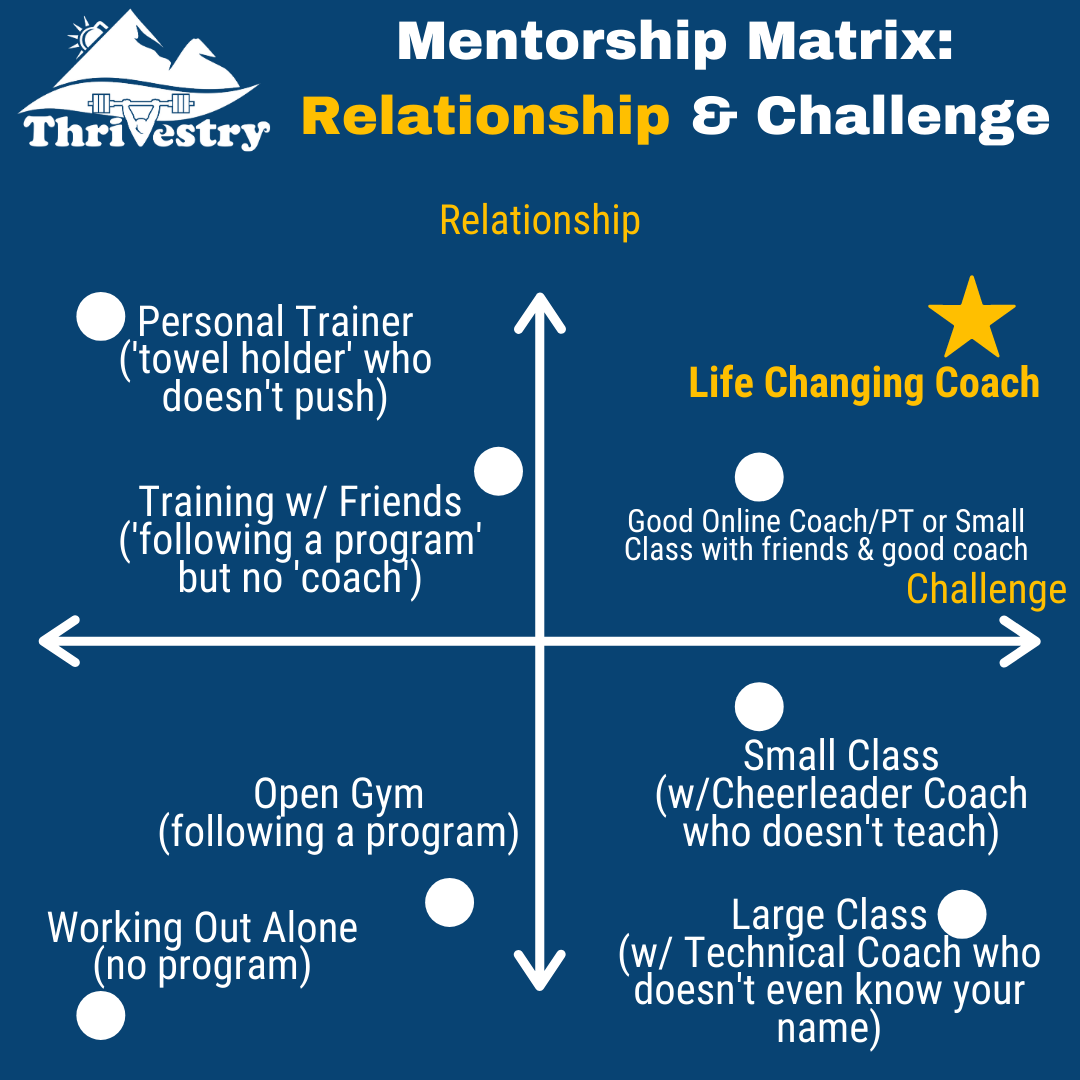
I’ve selected some common training situations and placed them on the matrix as examples relative to each other.
It is easy to see that most people training on their own at home or in a ‘globo gym’ are going feel stuck and frustrated. They are likely to train in fits and starts without ever really getting anywhere.
People who are paying for a personal trainer who isn’t well educated or who isn’t putting in the time to customize their client’s program is going to feel bored and like it isn’t worth the expense. They are likely to not get good results and start looking for other options.
The bottom right quadrant (where many HIIT and CrossFit classes end up being), is where many people feel overwhelmed and abandoned (by the staff). They feel embarrassed and like they ‘aren’t good enough’ to do that style of training.
A decent Personal Trainer or Online Coach is going to do a good job of getting to know you and helping you set up a plan. But if they don’t build the relationship first, and build trust with their clients, they will not be able to challenge them (and get better/faster results).
Smaller classes with good coaching and where everyone is friends (or, at least, more than acquaintances) can go a long way to producing a good amount of relationship and challenge. The smaller classes mean more one-on-one coaching for each person in class. The close nature of the group means more accountability and encouragement.
That said, small groups will never replace a strong one-on-one relationship. People will not be as comfortable sharing vulnerability in a group setting as they would sharing with their Coach/Mentor ‘in confidence’. There will not be enough time to customize each person’s experience (inside and outside of the gym).
The Path
Let’s analyze the best path to get to “Life Changing Coach”, but first let’s look at the most common way people are introduced into a challenging class-based environment.
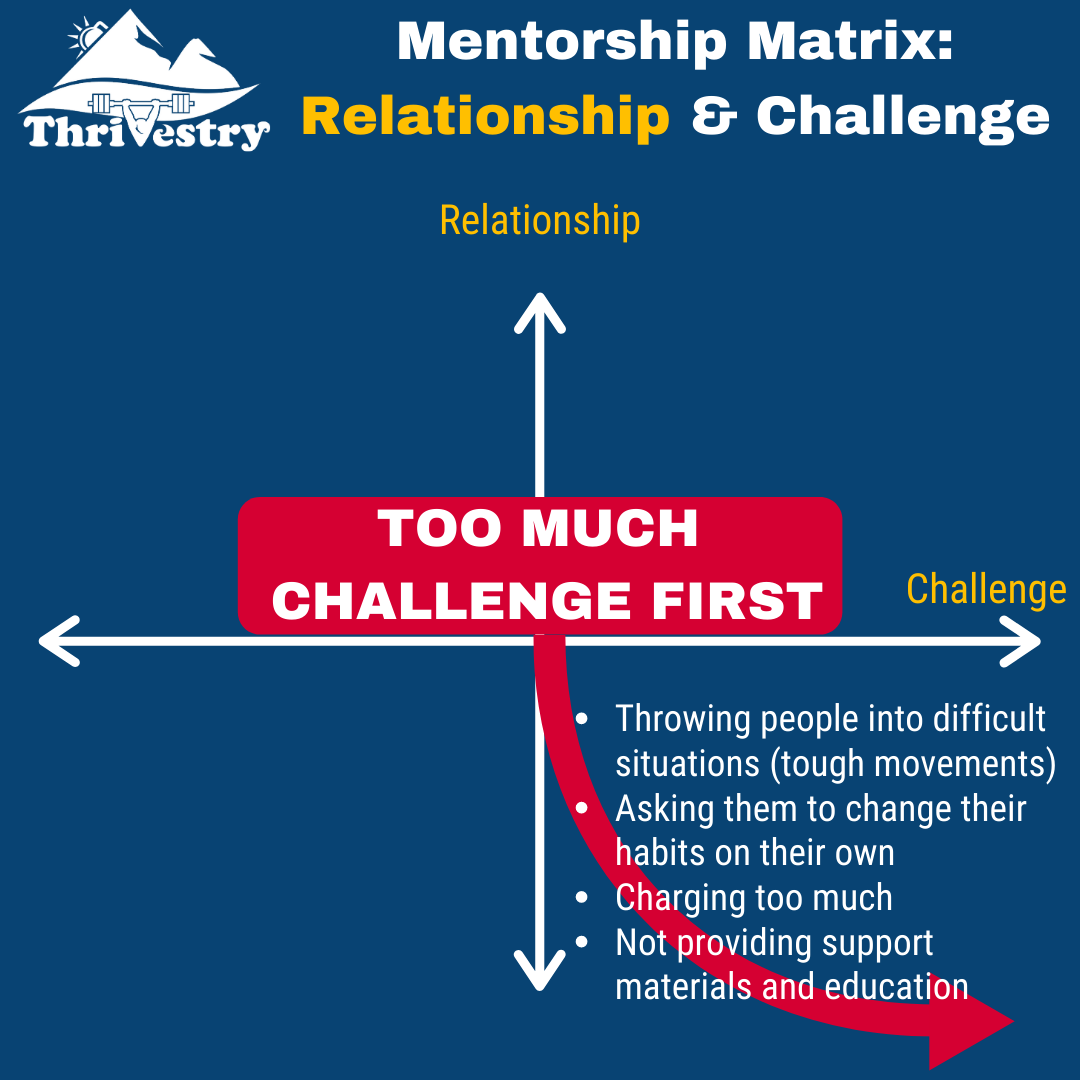
In many gyms, dojos, studios, (and even new jobs), people are given some basic information and they may meet some staff. They get shown around, given a handout, watch some videos, or do some small group intros.
People expect some challenges when they start something new, and they understand that it will take time to ‘get to know everyone’. Depending on how much they knew about what they were signing up for (through word of mouth and marketing), they may tolerate more challenge than others.
As things progress, they start to get frustrated by the lack of progress or how much is demanded of them. This compounds the amount of challenge they are facing.
They start to realize that this is harder than they expected. They also aren’t getting the help they need because the staff is focused on the new people, and the existing clients are in what seems like cliques that are hard to break in to.
The key here is that the more challenge they face, without the balance with relationship, the more likely they are to feel inadequate, embarrassed, and more likely to quit.
When we start with relationship first, we see a very different pattern:

In great communities/companies, far more time is devoted to developing the relationship first.
Before they demand too much of folks, their coaches/mentors/bosses get to know them and introduce them to as many people as possible, and build the bonds between people early on.
Once understanding and trust is formed, the mentor can start ‘challenging’ them with more responsibility. Their leader can start demanding more of them without causing resentment or burn out.
The person understands that the challenges presented to them are in their best-interest. They are comfortable coming to their mentor when they are struggling (rather than hiding their failures).
In gyms, this usually means a very involved ‘on-ramp’ program. In the best cases, this consists of many 1-on-1 sessions with the same coach or many small classes where they can get to know the ‘new folks’ intimately.
Side Note: Many CrossFit-Style gyms have this when they first open. The owner is the head coach and they know every individual well. They are vested in each person’s success. As the gym grows (usually past the 80-120 member mark), the owner’s influence is diminished. There are too many people to track and maintain a relationship with. This is why gyms struggle to get past the 100-150 member mark. Gyms that empower coaches to take on the mentor role have much greater success at retaining members and growing.
Let us Finally Talk About Web Cam Girls
If you aren’t aware, there is a new part of the ‘adult entertainment industry’ that has disrupted the established production studios.
I believe that I first learned about it in an article/video from Vice. It documented how performers from their homes were interacting with fans online.
In the previous decade or two, the primary way of consuming ‘adult content’ was by watching pre-recorded and produced photos or video. This new type of media involved live interactions between performers and fans online.
Fans could leave comments and the performers would respond.
The first ‘layer’ is dozens or hundreds of fans watching the same live performance. This level is usually more expensive than watching a pre-recorded video, and generally nets more revenue for a no-name performer.
The next level is for fans to pay for more ‘relationship’. Smaller gatherings or private shows. These interactions generate a lot more revenue for the performers and fans are willing to pay more (aka: deal with more ‘challenge’).
The last level/layer involves much more one-on-one interaction. Calls and texts. The fan starts to have what is perceived as an ‘intimate’ relationship with the performer. This is the most expensive and is generally the secret to the most successful performers.
These performers have discovered that there are many fans just looking for some type of ‘relationship’.
In fact, most performers note that their biggest fans aren’t asking for more extreme acts or fulfilling ‘fringe fantasies’. They are paying for more connected-ness/intimacy (relationship). They want someone to talk to, to be vulnerable with, and to not worry about being judged.
This new level of connection is so powerful, it is causing the established studios major concern. It analogous to the Big Box Gyms (‘Globo Gyms’) starting to notice that their previous model is flawed when compared to the explosion of ‘Micro Gyms’.
The cheap option that focuses on volume, and low relationship, will only work for some people and usually only for a short amount of time.
The service that fosters relationship and connection is what people are really looking for/need. And they are willing to pay for it once they recognize the value.
The Fitness Industry and the Oil Embargo of 1973
So now you can see how Jesus, Webcam Girls, and Coaches, have something in common: The most successful way to engage people is to focus on relationships first.
But what does this have to do with the Oil Embargo of 1973-1974?

In 1973 there was an embargo of petroleum to the United States that caused a shortage of fuel for cars and gas for heating homes.
The price of gas quadrupled. There was shortages and rationing. In the states, you could only buy gas on certain days based upon your license plate number and, in some places, you had to wait hours in line to get gas.
This had a major impact on ‘non-essential’ businesses. People needed to decide if they were going to drive to work and the grocery store, or if they were going to go to the gym and the salon (remember that many cars at the time got about 10 miles per gallon).
Sanctions were eventually lifted, but by 1980 gas was TEN TIMES higher than it was in mid 1973 (can you imagine paying $20-30 per gallon for gas in 7 years?)!
The immediate, and subsequent, economic impact meant that many businesses were forced to close. Gyms and martial arts studios especially.
But there were some gyms/studios that weathered the crisis.
In fact, because they were able to stay in business, they were able to grow exponentially once people were able to invest in themselves (rather than just making ends meet). This is because they were the only facilities available as the economic tide shifted.
Two of the businesses that thrived were Arthur Murray Dance Studios and Tracy’s Karate Studios. You can read more about their business model and story here.
Ultimately what helped them survive was the simple fact that they focused on relationships first (just like Jesus and the Camgirls).
They had invested in building long term ‘relationships’ with their clients, so when the ‘challenge’ of an oil embargo came, they had far less attrition than those options that focused on volume or something else.
Once things started to return-to-normal, they were able to take advantage of the demand created by the lack of options. Their locations benefited by the new influx of clients, their clients benefited from the level of experience their coaches had from being in the business 10+ years.
If you are looking for more information about these concepts (in particular, in relation to COVID-19) I talk about it with Eric at Push Press here:
The Wrap Up
Jesus taught us to lead with empathy and relationships before asking people to go outside of their comfort zone.
Webcam Girls taught us that people are willing to pay more for connection/relationships.
The Oil Embargo taught us that ‘deposits in the relationship account will pay dividends when people are faced with challenges’…
If you are building a business, or trying to save one that is struggling, DOUBLE DOWN on relationships first.
Create systems and training that will enable your staff to engage with people on a personal level.
Remember that building relationships first will allow you to help more people, create ‘better’ clients, and keep them longer as they get faster results and deal with set-backs (like an injury, a nation-wide shut down, or economic down-turn).
Thrive on.
-jj
Please share this if you found it useful or if you think it might help someone else.
Here are a few other things you may find interesting:
Personality Styles and Online Coaching
When working remotely with people one-on-one or in a group, it is important to understand them from a personality-type standpoint. Here is a tool you can use to help deliver a better online coaching service!
The BIGGEST Problem with the Fitness Industry
What if I told you there needs to be a monumental shift in the fitness industry?
Fitness professionals, enthusiasts, and facilities are focusing on the wrong things...
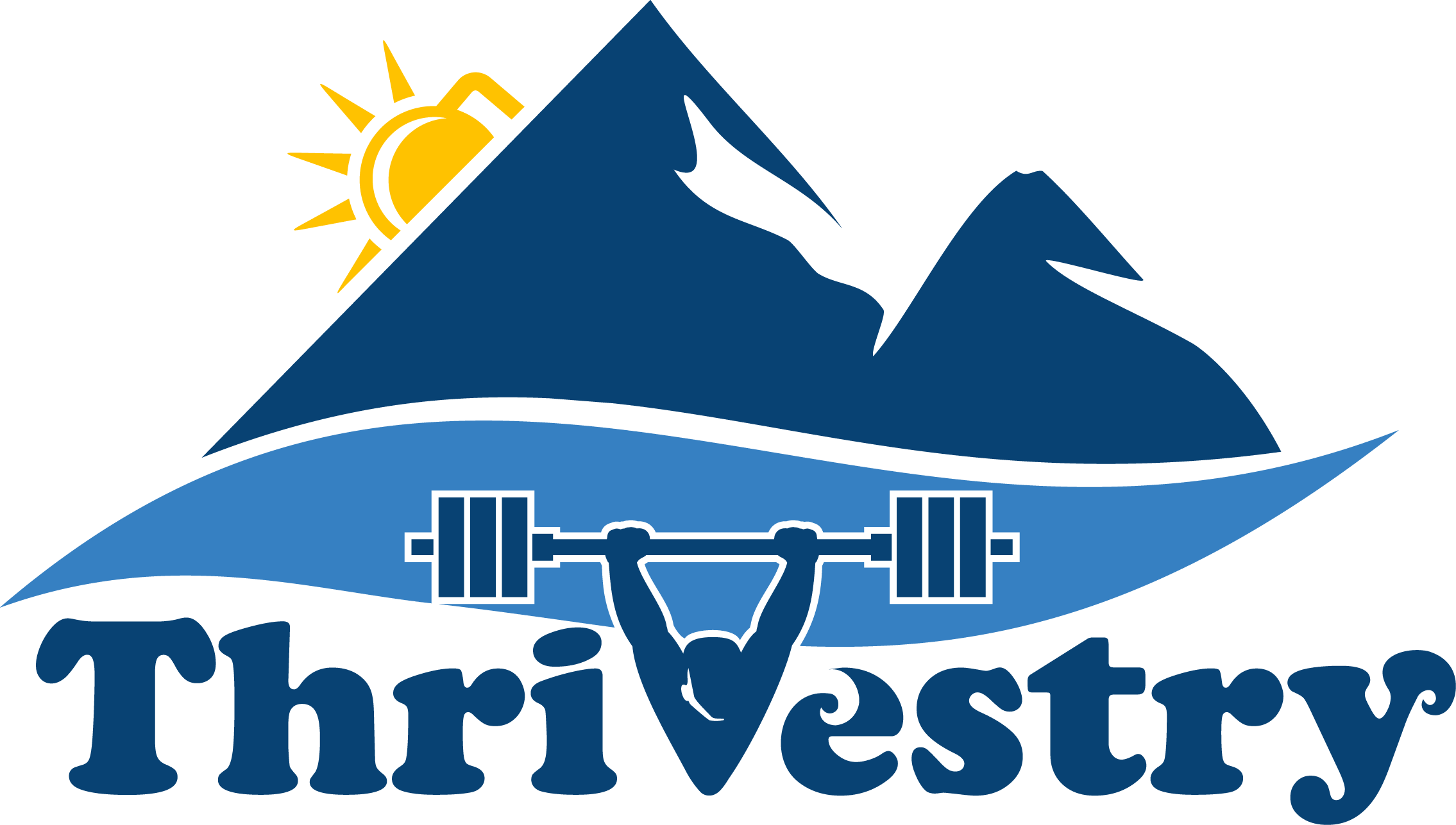
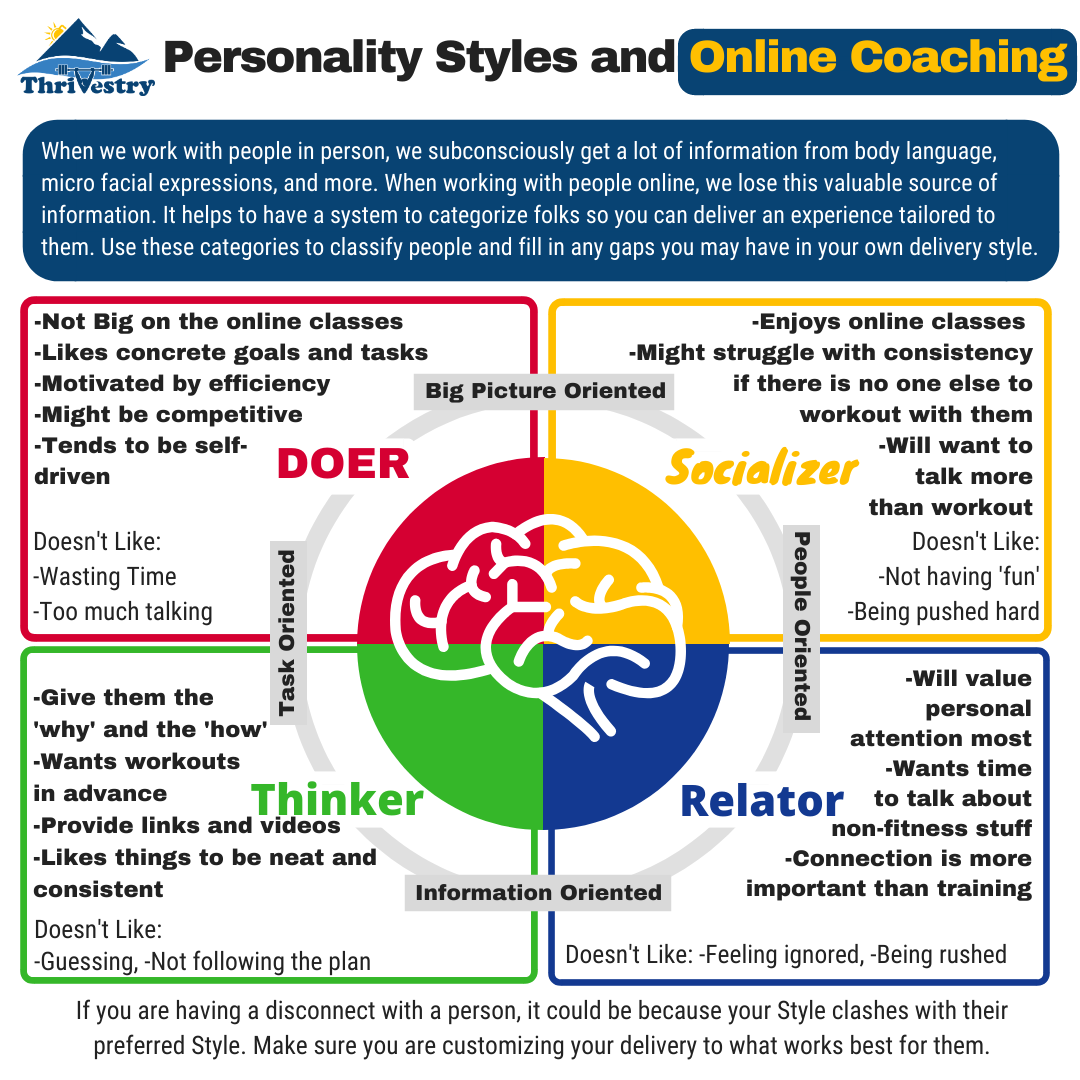

0 comments
Leave a comment